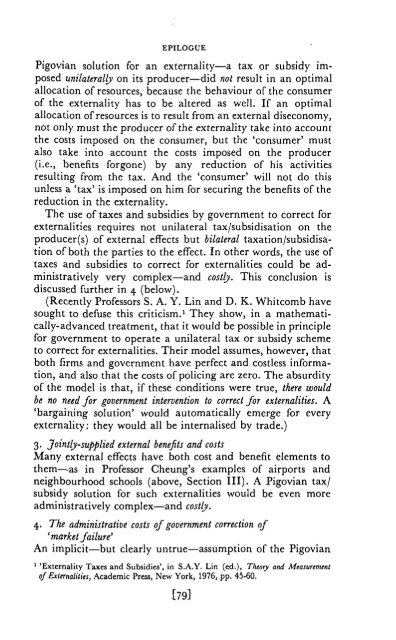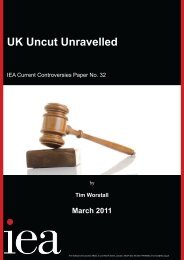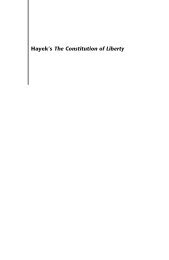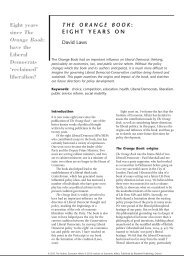THE MYTH OF SOCIAL COST.pdf - Institute of Economic Affairs
THE MYTH OF SOCIAL COST.pdf - Institute of Economic Affairs
THE MYTH OF SOCIAL COST.pdf - Institute of Economic Affairs
Create successful ePaper yourself
Turn your PDF publications into a flip-book with our unique Google optimized e-Paper software.
EPILOGUE<br />
Pigovian solution for an externality—a tax or subsidy imposed<br />
unilaterally on its producer—did not result in an optimal<br />
allocation <strong>of</strong> resources, because the behaviour <strong>of</strong> the consumer<br />
<strong>of</strong> the externality has to be altered as well. If an optimal<br />
allocation <strong>of</strong> resources is to result from an external diseconomy,<br />
not only must the producer <strong>of</strong>the externality take into account<br />
the costs imposed on the consumer, but the 'consumer' must<br />
also take into account the costs imposed on the producer<br />
(i.e., benefits forgone) by any reduction <strong>of</strong> his activities<br />
resulting from the tax. And the 'consumer' will not do this<br />
unless a 'tax' is imposed on him for securing the benefits <strong>of</strong> the<br />
reduction in the externality.<br />
The use <strong>of</strong> taxes and subsidies by government to correct for<br />
externalities requires not unilateral tax/subsidisation on the<br />
producer(s) <strong>of</strong> external effects but bilateral taxation/subsidisation<br />
<strong>of</strong> both the parties to the effect. In other words, the use <strong>of</strong><br />
taxes and subsidies to correct for externalities could be administratively<br />
very complex—and costly. This conclusion is<br />
discussed further in 4 (below).<br />
(Recently Pr<strong>of</strong>essors S. A. Y. Lin and D. K. Whitcomb have<br />
sought to defuse this criticism. 1 They show, in a mathematically-advanced<br />
treatment, that it would be possible in principle<br />
for government to operate a unilateral tax or subsidy scheme<br />
to correct for externalities. Their model assumes, however, that<br />
both firms and government have perfect and costless information,<br />
and also that the costs <strong>of</strong> policing are zero. The absurdity<br />
<strong>of</strong> the model is that, if these conditions were true, there would<br />
be no need for government intervention to correct for externalities. A<br />
'bargaining solution' would automatically emerge for every<br />
externality: they would all be internalised by trade.)<br />
3. Jointly-supplied external benefits and costs<br />
Many external effects have both cost and benefit elements to<br />
them—as in Pr<strong>of</strong>essor Cheung's examples <strong>of</strong> airports and<br />
neighbourhood schools (above, Section III). A Pigovian tax/<br />
subsidy solution for such externalities would be even more<br />
administratively complex—and costly.<br />
4. The administrative costs <strong>of</strong> government correction <strong>of</strong><br />
'market failure'<br />
An implicit—but clearly untrue—assumption <strong>of</strong> the Pigovian<br />
1 'Externality Taxes and Subsidies', in S.A.Y. Lin (ed.), Theory and Measurement<br />
<strong>of</strong> Externalities, Academic Press, New York, 1976, pp. 45-60.<br />
[79]












